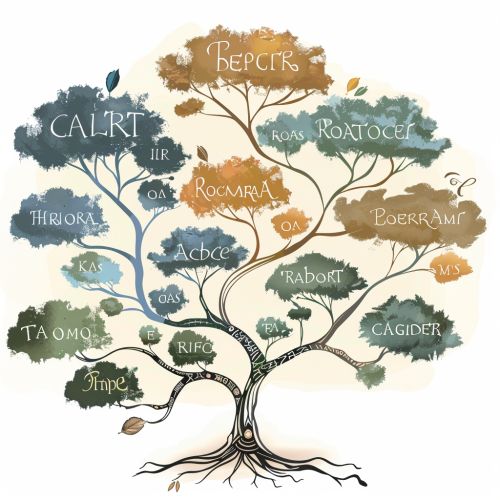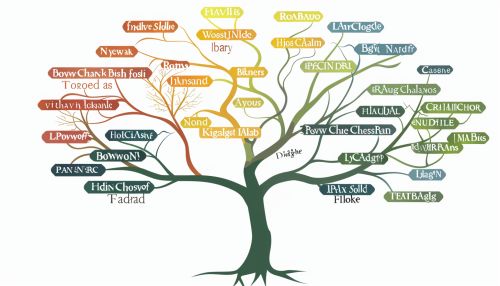Comparative linguistics
Introduction
Comparative linguistics, also known as comparative philology, is a branch of historical linguistics that is concerned with comparing languages to establish their historical relatedness. This field of study aims to reconstruct the features of a common ancestor language by examining similarities and differences among languages. Comparative linguistics plays a crucial role in understanding the evolution of languages, the migration of peoples, and the diffusion of cultures.
Historical Background
The roots of comparative linguistics can be traced back to the late 18th and early 19th centuries. The discovery of the Indo-European language family by Sir William Jones in 1786 marked a significant milestone. Jones observed striking similarities between Sanskrit, Latin, and Greek, suggesting a common origin. This led to the development of the comparative method, which became the foundation of comparative linguistics.
The Comparative Method
The comparative method is a systematic approach to comparing languages. It involves several steps: 1. **Identification of Cognates**: Words in different languages that have a common origin are called cognates. For example, the English word "mother" and the German word "Mutter" are cognates. 2. **Sound Correspondences**: Regular patterns of sound changes are identified. For instance, the Proto-Indo-European *p* becomes *f* in Germanic languages (e.g., Latin "pater" vs. English "father"). 3. **Reconstruction of Proto-Languages**: By analyzing cognates and sound correspondences, linguists reconstruct the features of a proto-language. Proto-Indo-European is the most well-known reconstructed language. 4. **Internal Reconstruction**: This involves analyzing irregularities within a single language to hypothesize about its earlier stages.
Language Families
Languages are grouped into families based on their historical relationships. Some of the major language families include:
- **Indo-European**: This is the largest language family, including languages such as English, Spanish, Russian, and Hindi.
- **Sino-Tibetan**: This family includes Chinese and Tibetan languages.
- **Afro-Asiatic**: This family includes Arabic, Hebrew, and Amharic.
- **Niger-Congo**: This family includes Swahili, Yoruba, and Zulu.
- **Austronesian**: This family includes Malay, Tagalog, and Hawaiian.
Phonological Comparisons
Phonology, the study of sound systems, is a critical aspect of comparative linguistics. Phonological comparisons involve examining the sound inventories and phonotactic rules of languages. For example, the Proto-Indo-European phoneme *k* appears as *h* in Greek (e.g., PIE *kerd* becomes Greek *kardia*).


Morphological Comparisons
Morphology, the study of word structure, is another key area. Comparative linguists analyze morphological features such as inflectional endings, prefixes, and suffixes. For example, the Proto-Indo-European verb conjugation system can be partially reconstructed by comparing the verb forms in Latin, Greek, and Sanskrit.
Syntactic Comparisons
Syntax, the study of sentence structure, is also examined in comparative linguistics. Linguists compare syntactic features such as word order, agreement, and subordination. For instance, the basic word order in Proto-Indo-European is believed to have been Subject-Object-Verb (SOV), based on evidence from ancient languages like Sanskrit and Hittite.
Lexical Comparisons
Lexical comparisons involve analyzing the vocabulary of languages. This includes identifying loanwords, calques, and semantic shifts. For example, many English words are borrowed from Latin and French due to historical contact.
Dialectology and Language Variation
Comparative linguistics also studies dialects and language variation. Dialectology involves comparing regional varieties of a language to understand their historical development. For example, the differences between British and American English can be traced back to historical changes after the colonization of America.
Applications of Comparative Linguistics
Comparative linguistics has several practical applications:
- **Language Reconstruction**: Reconstructing proto-languages helps linguists understand the history and evolution of languages.
- **Language Classification**: Classifying languages into families provides insights into human prehistory and migrations.
- **Linguistic Typology**: Comparative studies contribute to linguistic typology, the classification of languages based on structural features.
- **Language Preservation**: Understanding the historical relationships between languages can aid in the preservation and revitalization of endangered languages.
Challenges and Criticisms
Comparative linguistics faces several challenges and criticisms:
- **Lack of Written Records**: Many languages have no written records, making reconstruction difficult.
- **Language Contact**: Borrowing and language contact can obscure historical relationships.
- **Subjectivity**: Some aspects of the comparative method are subjective, leading to different interpretations.
- **Genetic vs. Areal Features**: Distinguishing between genetic and areal features (features shared due to contact rather than common origin) can be challenging.
